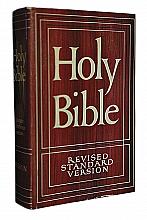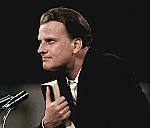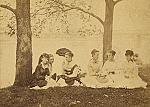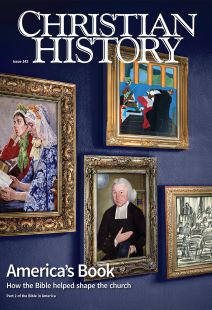Whose Bible?

[Domingo Mora, Faith (Church members holding services outdoors), 1898. Front facade of the Congregational House, Boston, Massachusetts—Daderot / [CC0] Wikimedia]
Imagine a Bible—in fact, imagine your Bible. Maybe it’s an “old-fashioned” family Bible, black hardback with a faux-leather spine and gold gilt around the trim, a thin red ribbon marking a passage near the middle. Or perhaps you think of your church’s Bible as your Bible—a large Bible for worship, too large to pick up with one hand, lying open on a pulpit or lectern or displayed in a large gold stand on an altar.
Maybe you think of a paperback with no verse numbers, presented in a modern paraphrase, aimed at reaching the unchurched. Maybe when you reach for your Bible you open an app launched from a phone, on the home screen right next to Facebook and Instagram, with 40 different downloaded translations. And, for the last two years at any rate, your Bible could be a PowerPoint shared in a Zoom church gathering.
All of these Bibles have at least one thing in common—we all interpret them through our own particular lens. Just look at the land in which we live. It is peppered not only with millions of different copies of the same book but also with hundreds of different denominations and innumerable independent churches totaling upward of 250 million different readers (see “Did you know?,” inside front cover). And then there are the dozens of different translations we have to choose from!
As though no one had read them
While interpreting the Bible for oneself is not uniquely American, it is particularly American. (For more on this, see our first issue in this series on the Bible in America, CH 138). Liberated by the new nation’s emphasis on the separation of church and state and empowered by a belief in the competency of the everyday citizen, the early nineteenth century saw a splintering of the religious landscape as Americans began to read and interpret the Bible for themselves apart from traditional authoritative structures. With no state church to rule on the nation’s official theology, they multiplied as many different interpretations of how to pray, study, worship, and apply the lessons of Scripture as there were churches—or even people.
Summarizing that common ideal, Alexander Campbell (1788–1866), one of the founders of what would become the Disciples of Christ, confessed in 1826 to reading “the Scriptures as though no one had read them before me.” Indeed for Campbell that sometimes meant ignoring even the interpretation he gave only the week before! (Read more about Campbell in CH 106.)
Historian Nathan Hatch once described this peculiar cultural phenomenon as “the democratization of American Christianity.” Within a few decades of the nation’s founding, Americans had become their own private interpreters, the Bible in their hands a unique Word to each of them.
As many strands make up this story of the Bible in America as there are readers of the book. Yet two strands stand out as representative—the rise of liberationist interpretation in the nineteenth century and the proliferation of new Bible translations in the twentieth.
A War of words
Nowhere else did the democratization of biblical interpretation in America take on more vivid display than in the antebellum debate over slavery. “Between the Christianity of this land, and the Christianity of Christ,” Frederick Douglass
(1818–1895) wrote in 1845, “I recognize the widest possible difference—so wide, that to receive the one as good, pure, and holy, is of necessity to reject the other as bad, corrupt, and wicked.”
Abolitionist arguments like Douglass’s regularly highlighted the “Golden Rule” of Matthew 7:12 (KJV): “Therefore all things whatsoever ye would that men should do to you, do ye even so to them: for this is the law and the prophets” and tended to emphasize the spirit of the Bible’s overarching story of exodus and salvation over its more literal letter.
These interpretations ran up against a wall of proslavery arguments, which often employed the exact same biblical texts. Gaining an audience before the governor of South Carolina late in 1822, Baptist Richard Furman (1755–1825), a slaveholder himself and one who had recently helped put down Denmark Vesey’s revolt of the enslaved, practically huffed at the need to explain that his right to enslave people “is clearly established by the Holy Scriptures, both by precept and example.”
To Furman anyone who contested slavery was contesting Scripture. Even the Golden Rule must suffer some restrictions: “The Christian golden rule, of doing to others, as we would they should do to us, has been urged as an unanswerable argument against holding slaves,” he said, but nobody would dare presume that a father give in to his child’s every whim, much less a slaveholder to those he enslaved.
Surely Jesus didn’t intend anarchy! Hence the purpose of Christian benevolence according to proslavery advocates like Furman was not to overturn the divine order of things—America’s system of enslavement included—but rather to direct actions within it. Whose Bible, then, was the real one? Was it Furman’s or Douglass’s? Whose interpretation would ultimately win out? The nation, of course, would decide through a bloody civil war.
Princes shall come out of Egypt
Even among readers of Scripture committed to expanding freedom, shades of opinion still existed. The historian Albert Raboteau (1943–2021), in his study of nineteenth-century African American Christianity, noted three different interpretations of a single verse, Psalm 68:31, “Princes shall come out of Egypt; Ethiopia shall soon stretch out her hands unto God.”
Was the psalmist referring to the inherent dignity of the “African race” or to the future salvation of the African people? Might this verse instead be an indicator that one day Black Christians would prove “the leaven of true Christian civilization”? Even accounting for similar cultures, contexts, and situations, the plurality of biblical interpretations runs deep.
Consider the interaction of America’s White settlers and their Native American neighbors. Each read the biblical story of the Exodus and identified with the plight and promise of ancient Israel. Yet while the former saw themselves as manifestly destined to conquer a new Promised Land (the West), having already escaped through their own Red Sea (the Atlantic), the Native peoples they displaced identified with the Hebrew slaves still stuck in Egypt. “We regarded ourselves,” William Apess (1798–1839), a Pequot Methodist minister, once explained, “as a tribe of Israelites suffering under the rod of despotic pharaohs; for thus far, our cries and remonstrances had been of no avail.”
As with Frederick Douglass, Native Americans found hope and the promise of their deliverance in the same Bible so often used to oppress them. At the same time, missionaries were beginning translations into many Native languages, as Alfred and Harriet Wright began working on a Choctaw translation (see p. 32).
Nineteenth-century America also witnessed a concerted push for women’s suffrage and other liberties, with the Bible again rising to the top as a contested centerpiece. Sojourner Truth’s (c. 1797–1883) famous 1851 speech, “Ain’t I a Woman?,” made explicit use of Scripture to link what she believed to be the twin issues of racial and gender equality. Calling out every preacher who dared suggest that because Jesus was male women are somehow inferior, she argued, “Where did your Christ come from? From God and a woman! Man had nothing to do with Him.” If the first woman God created could turn the world upside down, Truth insisted, her eye on Genesis 3, then surely women today could turn it right side up.
Later generations of women’s rights activists followed Truth’s lead, including Anna Julia Cooper (1858–1964), Sarah Grimké (1792–1873), Lucretia Mott (1793–1880), Mary S. Parker (1802–1841), Elizabeth Cady Stanton (1815–1902), and Frances Willard (1839–1898). Often lumped together under the category of “first-wave feminists,” these women pushed against patriarchal interpretations of Scripture—arguing, for instance, that the “Curse of Eve” in Genesis 3:16 was less a divine command than a sad prediction of precisely the kind of destructive inequality women faced every day.
Stanton’s The Woman’s Bible (1895) sent biblical interpretation as a discipline into new territory. Not content to offer competing egalitarian scriptural interpretations, this collection of essays highlights how Stanton and her 26 contributors thought that the Bible elided women’s experiences, silenced their perspectives, and contributed to inequality (see pp. 19–21). The shock waves caused by such criticism of the Bible itself (not simply criticisms of our interpretations) would echo for generations and influence later Christian feminists such as Phyllis Trible and her Texts of Terror (1984).
By the late twentieth century, then, Americans were not only asking “Whose Bible?” of each other but “Whose Bible?” of the various voices found within the biblical text.
One Word to rule them all
If the nineteenth century told the story of competing interpretations of Scripture, Americans at least agreed on a common translation from which to interpret, the King James Version (see pp. 29–31). The twentieth century changed that. What began with the Revised Version in 1885 as a relatively innocuous attempt by British scholars to update the KJV’s archaic language and incorporate the discovery of more accurate biblical manuscripts quickly became a battleground over whose Bible translation should be considered real and authoritative.
This contention was evident even in the titles of the translations themselves. When the Revised Version crossed the Atlantic in 1901, it officially became the American Standard Version. That “standard” translation set the bar. As the translation movement kicked into high gear toward the midway point of the century, each new version worked to better its predecessors, beginning with the Revised Standard Version of 1952 and continuing on with the New American Standard (1971), the New Revised Standard (1989), the English Standard (2001), the Holman Christian Standard (2004), and many more. Even the New International Version (1978), which escaped this “standard” nomenclature, began as a theologically conservative response to the RSV. Rarely did a new translation come out in the latter half of the twentieth century that did not compete ideologically with earlier versions.
The Revised Standard is a case in point. Before its pages had even cooled off the press, the translation already found itself embroiled in controversy. Climbing up onto the bed of his pickup truck in rural North Carolina, the Reverend Martin Luther Hux (1911–1982) decided there was nothing for it but to light his new copy of the RSV on fire—or at least the page containing Isaiah 7:14, “Therefore the Lord himself will give you a sign. Behold, a young woman shall conceive and bear a son, and shall call his name Immanuel.”
By substituting “young woman” for the traditional “virgin,” Hux and his compatriots believed, the RSV had effectively denied the full divinity of Christ. Looking out over a crowd waving miniature American flags, Hux shouted, “This has been the dream of modernists for centuries, to make Jesus Christ the son of a bad woman.” Should we have asked him that evening whose Bible he held in his hands, he surely would have said it wasn’t his or that of any faithful Christian. “I never said I would burn the Bible,” he winked. “I said I would burn a fraud.”
Thirty-odd years later, the RSV’s successor would suffer a similar fate, this time for incorporating inclusive language in its translation. Commenting on the New Revised Standard Version and similar gender-inclusive translations, Wayne Grudem, then president of the Council on Biblical Manhood and Womanhood, warned:
If evangelical translators and publishers give in to the principle of sacrificing accuracy because certain expressions are thought to be offensive to the dominant culture, this altering of the text of Scripture will never end. And then readers will never know at any verse whether what they have is the Bible or the translator’s own ideas.
Grudem feared the Bible itself was becoming increasingly lost in a sea of interpretation, and if this continued unchecked, we might never know whose Bible we hold in our hands or even if it is worth calling a Bible at all. By the end of the twentieth century, not only had the preponderance of translations furthered the democratization of the Bible, it had become a source of conflict in a growing culture war.
Which interpretation?
Many more stories abound about biblical interpretation in America as Christians have interacted among themselves as well as with Muslims and Jews. As historian Jonathan Sarna noted, “Jewish biblical exegesis, by its very existence, complicated American Christian ideas of following the ‘Bible alone.’ If, after all, there were multiple texts and interpretations of the Bible, how could all of them be true?”
Jews, of course, do not regard the Christian New Testament as part of their Bible, but even Catholics, Protestants, and the Orthodox disagree on what exactly makes up the contents of Holy Scripture. If my Bible includes different books than your Bible, are they even the same Bible? Whose Bible do we hold? The story of biblical interpretation in America is the story of the Bible’s readers—every last one of them—which means it’s the story of us all.
CH
By Jason A. Hentschel
[Christian History originally published this article in Christian History Issue #143 in 2022]
Jason A. Hentschel is preaching pastor at Wyoming Baptist Church in Wyoming, Ohio, and the author of numerous essays and articles on the history of religion and American culture.Next articles
Some English Bible translations and paraphrases
A version for every taste and reading level
the editorsGiving sinners no rest
Preaching from the Word during American awakenings
Keith J. Hardman and Jennifer Woodruff TaitSupport us
Christian History Institute (CHI) is a non-profit Pennsylvania corporation founded in 1982. Your donations support the continuation of this ministry
Donate







